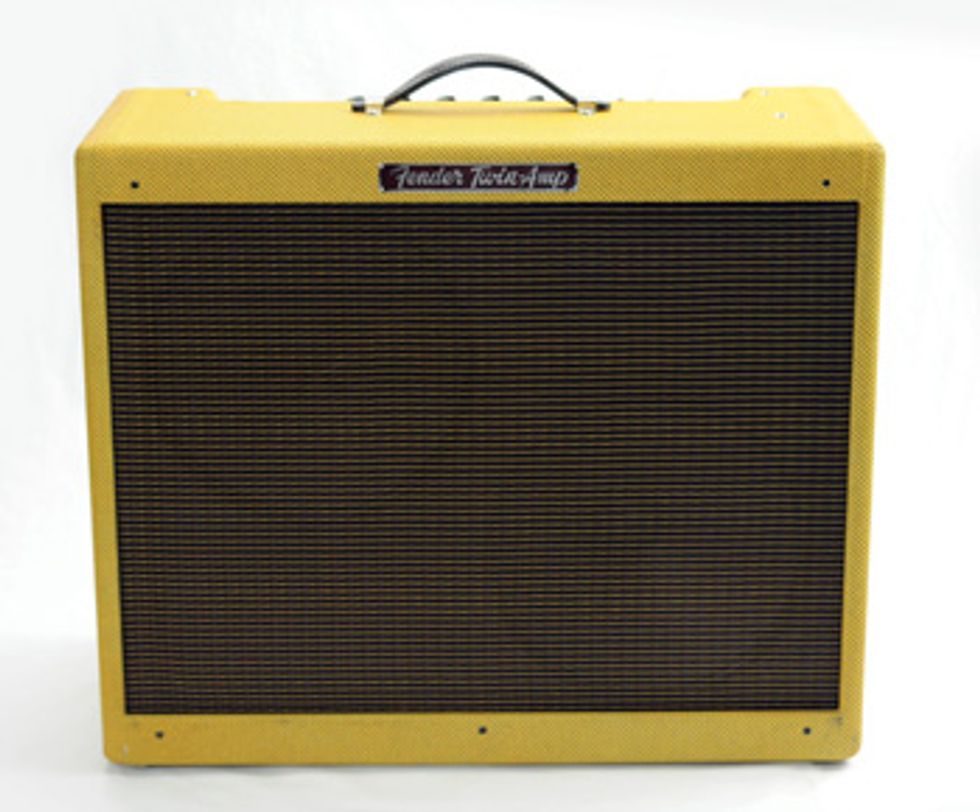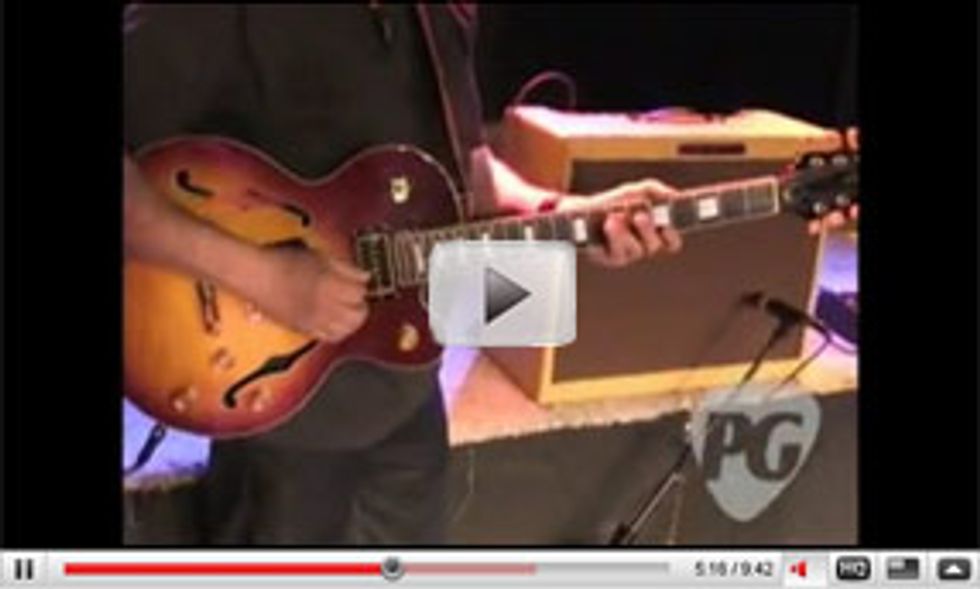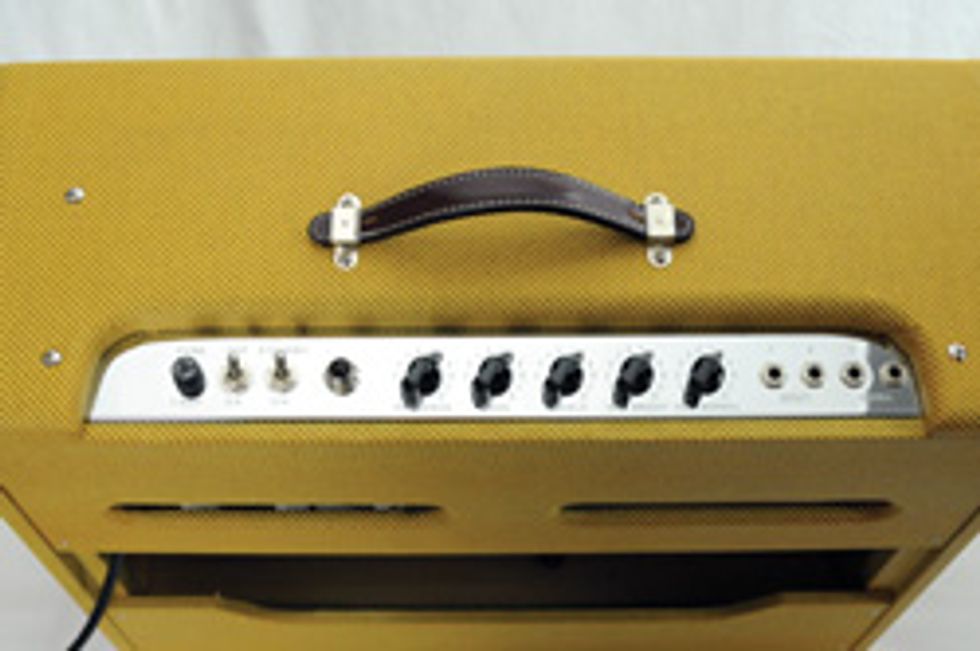 | |
| Download Examples 3.9MB Zip file with 10 mp3s and description | |
Watch a video review: | |
It didn’t take Fender long to figure out that there was a market waiting for reissues of some of their most revered models, and thus followed a steady stream of amps that bore the Fender logo and looked just like the amps of yore. Most contemporary players understood the choice of the first series of reissue models, but sometime around 2004 the ’57 Twin (model 5E8-A, also known as the low-power Twin) came out, and the less vintage-oriented players scratched their gearheads and wondered.
What’s up with the ’57 Twin?
The first Fender amps (and most others) were born out of circuits printed in the back pages of tube manufacturers’ catalogs suggesting ways to use their new audio tubes. The early circuits based on these primitive tubes were simple, and the initial amp models were wimpy, but somewhere against the hum of these primordial beasts the sharp report of the starter’s pistol signaled the beginning of the amplifier race.
Leo Fender could not play the guitar, but he had a knack for translating into products the suggestions and demands of those who could. Most of his advisers were the country guitar and steel players of southern California, with a few big-city rock ‘n’ rollers thrown in. The professional players wanted loud. They needed to fill the sonic space of large ballrooms, dance halls, roadhouses and outdoor celebrations without the benefit of the Front of House monoliths that are seen at today’s large venues. Beginning in 1952 at 25 watts, the Twin Amp was Leo’s answer to this demand.
The Twin underwent constant modification and several model changes in the years to follow. As the models changed, the power output increased. What is unique about the 5E8-A is that it used two 5U4 rectifier tubes (higher power rectifiers had not been invented yet) to prevent the sag of the attack/decay envelope and allow a decrease in the negative feedback loop to the tone stack. This made the Twin loud and punchy enough to cut through, but also allowed another browner, spongy tone favored mainly by Blues players by simply removing one of the rectifiers.
The subsequent Twin Amp models featured four output tubes and high-power or solid-state rectifiers and many more output watts, making them suitable only for very loud rock gigs and large venues.
 Meet the Beastie
Meet the Beastie The ’57 Twin RI is a replica of its predecessor manufactured by the Fender Custom Shop (with a few changes thrown in for versatility’s sake). The nicely applied lacquered Tweed cloth covers a finger-jointed, solid-pine cabinet with a thin leather handle (more on that later). The chromed steel vertical chassis houses highquality components mounted on a sturdy black fiberglass eyelet board, sturdy tube sockets, and nicely done point-to-point wiring. The switches, jacks and pots are high quality and the transformers and choke are from the highly regarded Mercury Magnetics Company. There is a bias adjustment pot on the circuit board.
The tube complement includes four Sovtek 12AX7WCs, relabeled Groove Tubes 12AX7- R; two Groove Tubes-6L6GE (made in the USA) and two Electro Harmonix 5U4GB rectifiers. The speakers are 12” Eminence Alnicos designed by Ted Weber (of Weber VST), which look remarkably like Weber P-12Ns. The top rear-positioned control panel features five chicken-head knobs, which all traverse from 1–12 (take that, Nigel). There are separate Bright and Normal channels, each with its own preamp circuit, separate Volume controls and two jacks, followed by Treble, Bass, and Presence controls that are common to both channels.
Comparing schematics of old and new, there are some relatively important differences. The original used three 12AY7 preamp tubes (but the same AX as the phase inverter). There is no bias adjustment pot on the original, and output tube plate voltages have been increased in the reissue to 450V from original 400V. There are also a couple of internal fuses on the new circuit (good idea). The new circuit is geared toward a brighter, louder sound, with the flexibility of being able to adjust bias on output tubes to provide a more customized sound and allow changes of output tubes from one brand to another.
A few design considerations are in order for us “filament brains” and non-tech types as well. The old Fender amps were not very consistent in sound, due to the fact that the factory tended to use whatever components they had on hand at the time, often of loose tolerance, which led to variations in circuit voltages that could affect sound. Add to this the fact that there was no practical way of adjusting bias in this fixed-bias amp and you could end up with two amps that looked the same but sounded very different.
When Fender set out to make this ’57, they picked one particular amp that was admired by many top players and measured all the circuit parameters of that amp. They then used tighter-tolerance components and handwound transformers that individually tested to spec in order to replicate the sound of this amp.
Enough already, How Does it sound?
This being a brand-spanking-new amp, I subjected it to many hours of component and speaker burn-in/break-in before I even plugged in. When I plugged in, I was struck by how little it sounded the way I expected. The amp was loud indeed, but the high end was brittle and percussive, and there was very little of the singing sustain that I had come to expect from the Tweed series. This tone would probably be fine for a pedal steel sound, but I was looking for something more blues-rock oriented. I plugged in a Weber Bias-Rite and measured the bias current and plate voltage: 29mV and 475V respectively. Hmm. That alone could be the source of the problem. I checked the online Weber bias chart for these 6L6s and proceeded to gradually increase the bias current as I played the amp. At about 40mV, things started smoothing out, and at 45 the amp sounded very good—and I was still well within bias parameters. Plate voltages had dropped to around 450. [Note: there are dangers inherent in working on amplifiers, including lethal voltages. Do not attempt to service your amp, including bias adjustment, unless you’re properly educated and equipped to do so. A well-qualified amp tech will be able to help you obtain the sound you want.]
The sound was still punchy, but there was now a sweet but very ample top end and midrange, with a full, but not muddy, bottom. I suspected much of the punchy attack came from the speakers, so I plugged a couple of other amps into the same speakers making sure I stayed at a 4-Ohm load, and yes indeed they sounded just the way P-12Ns sound, which is a good thing, unless you have an amp that has a predominantly dark sound. This Twin has plenty of high end, making this speaker a good choice.
The noise floor of the amp is low, but it will hum with single coils. Nonetheless, I like the way Gibson single coils sounded with this setup and mainly used them for test playing and listening. I threw in a Strat with DiMarzio virtual vintage pickups, and an Ibanez with Schofield humbuckers, too.
With the Normal channel set at 5, Bright at 0, Treble at 8, Bass at 4 and Presence at 5, the tone was bright, clean, and sustained, sounding like the missing link between Tweed and Blackface. Increasing the Normal volume (V1) to a stageworthy 8 brought some clipping to the output that was mostly smooth and creamy with just a hint of buzz. Pulling one of the rectifiers didn’t result in much of a change, but a slight compression. There would be more sag at a higher gain setting.
The next tonal excursion led me to replace the missing rectifier and Y-cord the two input channels together, thereby pushing the output with both preamps. This really popped my cork! Smooth distortion with good bite and a bit of upper-mid feedback. Nice. I messed with the two V knobs and liked V1 at 7 and V2 at 5 for a medium stage volume. I reduced the treble to 6.
A Fender reverb tank made the sound (you guessed it) reverberant. Effect and gain pedals sounded fine but adversely affected tone purity. Humbuckers sounded very sweet and sustained with nice mid support, but without the P-90 grind.
I pulled the three preamp 12AX7s and replaced them with NOS RCA 12AY7s.That sound was good enough to eat: clean but sustained with more headroom. When pushed, the clipping was very smooth without the previous buzziness. I Y-corded the two channels and could not find a sound I didn’t like. If I wanted a bit more shimmer, up went the bright channel volume; more weight brought the normal channel into play.
Modifications are included in the documentation for the amp. There are many more things that can be done to a tube amp to change its sound, such as substituting different tubes (output tubes especially can make a large difference), or speaker substitution—even internal components may be easily changed (but only by someone aware of the risks of high-voltage circuits).
My one beef has to do with the thin leather handle. It is fine for lifting it out of a road case, but it hurts when you have to carry the amp more than a few yards. The amp is not light (53 pounds) and deserves a better handle. Fender acknowledges that the handles on the old amps did routinely break, and that the ‘50s-style leather handle of the reissue is intended for period-correct looks, and has a similar chance of breaking. Fender does provide a spare handle that, while it looks as uncomfortable as the original, is reinforced to increase its reliability.
The Final Mojo
If you’re a blues or classic rock player, this is an amp that you can take to the bank (may as well bring it along when you talk to the loan officer). It has classic Fender tone available in many easy-to-blend shades. If you like the way it sounds out of the box, great; if not, a trip to your favorite amp guru can get it up and running for your signature sound. It reveals excellent build quality with minimal coupling circuits and 5:8 knob-to-tube ratio—always a good sign, as far as I’m concerned.
Buy if...
youw ant a great-sounding and versatile amp with vintage tone and appearance and high reliability.
Skip if...
you need a lot of built-in bells and whistles, or you're not playing medium-to-large venues that provide medium-to-large paychecks.
Rating...
MSRP $3880 Street $3100 - Fender - fender.com |





![Rig Rundown: Russian Circles’ Mike Sullivan [2025]](https://www.premierguitar.com/media-library/youtube.jpg?id=62303631&width=1245&height=700&quality=70&coordinates=0%2C0%2C0%2C0)














